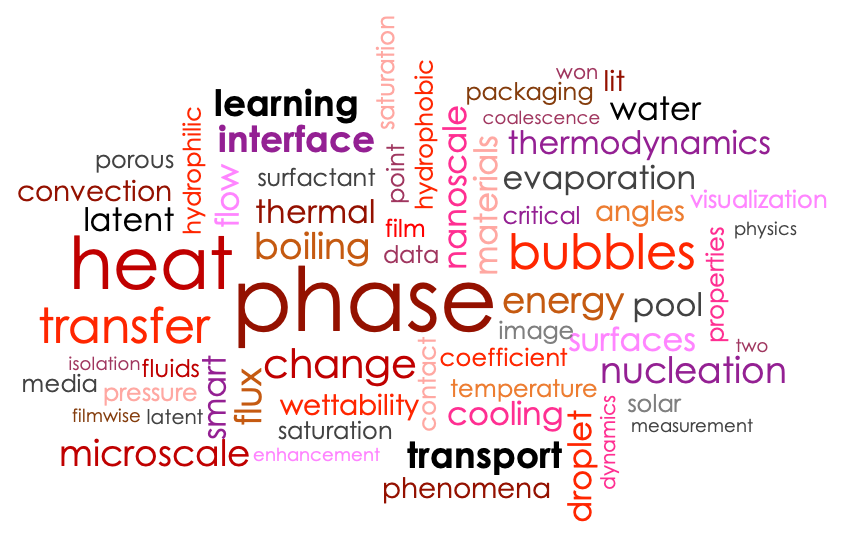Intelligent Thermofluidics Vision
An intelligent vision can significantly advance science. Liquid-vapor phase change processes (e.g., boiling, condensation) are naturally complex and involve the dynamic nucleation of the secondary phase (e.g., bubbles, droplets) on a surface. The knowledge connecting phase change and nucleation dynamics is essential but advancing it has been challenging due to the intrinsically complex and dynamic nature of nucleation processes. With recent advances in artificial intelligence, we have demonstrated artificial intelligence-enabled computer vision and developed the first data-driven framework that builds predictive models for thermal performance by conceptualizing deep learning models.
Data-driven Approach
This module aims to automate the process of AI vision and data analysis that extracts object statistics, low- and high-level features as well as spatiotemporal mapping with micrometer resolutions. The entire process thereby provides quantitative descriptions of underlying phase change activities that can potentially help discover unknown phase change principles. This research aims to leverage the recent advancements in computer and data sciences to develop a data-driven framework in the area of thermal sciences. We model the interconnected relationships among boiling/condensation surfaces, bubble/droplet statistics, and heat transfer performance by integrating experimental metrology, transfer learning, and sequence learning. Our achievements will provide a holistic and fundamental understanding of dynamic boiling physics, enabling the inverse design heat transfer performances.
Materials-driven Approach
Related to material defects and their properties, my group has identified for the first time defect- limited microscopic hydrodynamic impedances and evaporation within polycrystalline porous media, caused by the presence of defects or grain boundaries separating crystals. This defect-limited transport is dependent on crystal or grain structures, resulting in either direction-dominated or diffusive-like patterns, in a discretized manner. We have successfully separated individual crystal grains’ transport properties from polycrystals along with new probabilistic datasets, demonstrating statistical predictive models.
Nanos cale Phase Change Heat Transfer
cale Phase Change Heat Transfer
Recent advances in materials science and surface chemistry have made it possible to think about the absolute limits of phase change heat transfer including boiling, evaporation, condensation, and freezing. Phase change heat transfer often intertwines multiple transport problems in the system that requires different optimum length scales. A rational design of thermal metamaterials with desired wetting characteristics can create unique combinations of thermal and fluidic transport for performance breakthroughs in thermofluidic applications.
Atomistic Interfacial Properties
Phase change process is inherently multiscale, thus the demonstration of multiscale models should be addressed to establish new knowledge of interfacial phase change physics from the atomistic level to the continuum regime. For this purpose, we study a series of simulation models including molecular dynamics to calculate intermolecular forces and computational fluidic dynamics to calculate interfacial thermofluidic properties.
Microscopic Fluid Transport through Porous Materials
Delivering liquid through the void spaces in porous metals is a daunting challenge for a variety of emerging interface technologies ranging from battery electrodes to evaporation surfaces. Hydraulic transport characteristics of well-ordered porous media are governed by the pore distribution, porosity, and morphology. Much like energy transport in polycrystalline solids, hydraulic transport in semi-ordered porous media is predominantly limited by defects and grain boundaries. The understanding of microscopic liquid transport physics through porous crystals and across grain boundaries will help to pave the way for the spatial design of next-generation heterogeneous porous media.
Development of Thermalmeta Materials via Templated Synthesis
Modern nanoscale fabrication techniques such as self-assembly nanofabrication now can design and construct novel material architectures with unprecedented levels of control over structural properties. Nanofabrication through templating enables the pore morphology (i.e. porosity, distribution of pore sizes, and structural arrangement) to be tuned through the control of self-assembly and is often an inherently scalable technique. In particular, inverse opals, bijel-derived structures, nanowires, and nanosprings have been examples available from our group.
Interface Materials for Energy Harvesting
 Nanostructured materials offer unusual thermal, mechanical, and electrical properties, which vary with geometry, and length for a wide range of applications. Vertically aligned nanostructures including carbon nanotubes, nanosprings, or vertical nanowires, which combine mechanical compliance with high thermal conductivity, are promising thermal interface materials.
Nanostructured materials offer unusual thermal, mechanical, and electrical properties, which vary with geometry, and length for a wide range of applications. Vertically aligned nanostructures including carbon nanotubes, nanosprings, or vertical nanowires, which combine mechanical compliance with high thermal conductivity, are promising thermal interface materials.
Phase Separator for Liquid Retention
 Phase separation is a key to significantly reduce the pressure drop and improve the thermal performance of advanced thermal systems. The membrane aims to rigidly separate phases and impose a defined phase boundary. The separation decouples liquid and vapor transport in contrast to traditional two-phase techniques, like pool or flow boiling by using microporous structures. The conductive microporous structures integrated minimize thermal resistance by producing ultra-thin liquid films to support evaporation, and increase effective heat transfer coefficient due to their small feature size.
Phase separation is a key to significantly reduce the pressure drop and improve the thermal performance of advanced thermal systems. The membrane aims to rigidly separate phases and impose a defined phase boundary. The separation decouples liquid and vapor transport in contrast to traditional two-phase techniques, like pool or flow boiling by using microporous structures. The conductive microporous structures integrated minimize thermal resistance by producing ultra-thin liquid films to support evaporation, and increase effective heat transfer coefficient due to their small feature size.







